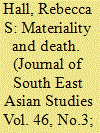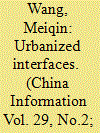|
|
|
Sort Order |
|
|
|
Items / Page
|
|
|
|
|
|
|
| Srl | Item |
| 1 |
ID:
142500


|
|
|
|
|
| Summary/Abstract |
Visual arts maintain a colourful presence at Buddhist funerals in Northern Thailand. These arts are not made for mere decoration but serve an active and essential role in the ceremonies that take place after death. They echo funerary themes of the impermanent nature of life and the importance of a life filled with merit. This article examines cremation structures and funeral banners of Northern Thailand and argues that these arts not only hold significance for the living and the dead, but that in giving form to abstract concepts they have the power to guide observers in their beliefs regarding the dynamics of life and death.
|
|
|
|
|
|
|
|
|
|
|
|
|
|
|
|
| 2 |
ID:
106038


|
|
|
|
|
| Publication |
2011.
|
| Summary/Abstract |
This article argues for a close relationship between national identity and the institutionalisation of the visual arts in Grenada. Art, which is intrinsic to all humans, predates its institutionalisation: it is only institutionalised in societies with a strong sense of national identity. In order to explain the role of national identity in the formation of national art, the article begins by examining the period following World War II, when Grenada - still under British colonialism - was undergoing intense social and political changes. To understand these changes, the analysis of the stratification system is paramount. The article delineates three groups on the basis of the value systems developed historically: the elite, the masses and a small, growing middle class situated between these two groups. The works of three prominent Grenadian artists illustrate the argument that institutionalisation of art requires a strong sense of national identity, and through this process the artistic development of a society occurs. Furthermore, understanding this process requires a focus on the ways in which social and political groups or classes impeded the development of a national identity, preventing the institutionalisation of the arts.
|
|
|
|
|
|
|
|
|
|
|
|
|
|
|
|
| 3 |
ID:
140504


|
|
|
|
|
| Summary/Abstract |
In the past two decades, unparalleled urbanization in cities across mainland China has deeply affected and transformed Chinese visual arts. Critical artistic and creative examinations of the interfaces between urbanization, society, culture, arts and people in Chinese cities have produced a great variety of new visual forms and agencies. In this introductory essay, we argue that the complexities of reciprocal relationship between urbanization and the visual arts deserve greater scholarly attention than they have been given so far, and we call for continuous and multiple-perspective research into the subject. The visual arts not only mirror the city but they actively participate in city-making processes. The investigation of artists, filmmakers and urbanites into the changing urban space in which they live has given birth to a post-socialist urban aesthetics, which, as Robin Visser proposes, functions as a new realm to envision, experience and assess the city. In doing so, it enables new forms of civic agencies to emerge. Visual art, as indicated by Yomi Braester in his study of Chinese films, interacts with political decisions and architectural plans, creating both material and ideological constructs of the cities. We maintain that the varied forms of visual arts and agencies discussed in this special issue not only reveal and interpret how the processes of globalization and urbanization are interrelated, but also participate in the reconstruction of sociospatial relationships and the reconceptualization of the city at local, national, and even global levels.
|
|
|
|
|
|
|
|
|
|
|
|
|
|
|
|
|
|
|
|
|